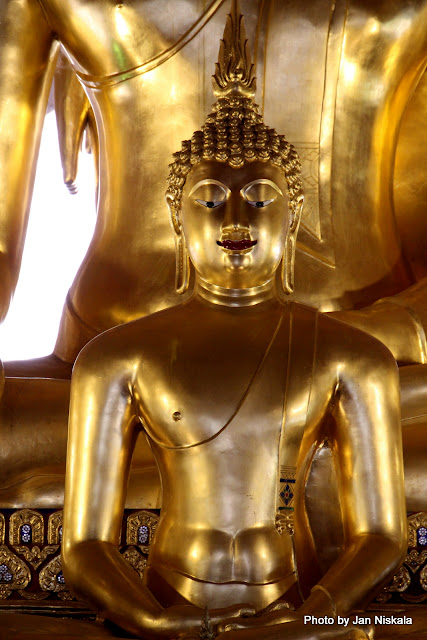Wat Suan Dok – Chiang Mai
Wat Suan Dok is a Buddhist temple (Wat) in Chiang Mai, northern Thailand. It is a Royal Temple of the Third Class and is west of the Suan Dok ancient gate at the
west side of the old moat. The Chiang Mai campus of the Buddhist Mahachulalongkornrajavidyalaya University is housed within the temple
compound.
Wat Suan Dok was founded by King Kue Na of Lanna for the monk Sumana Thera in the year 1370. The temple was built in the center of Wiang
Suan Dok, a walled settlement of the indigenous Lawa people who were older than Chiang Mai itself. The remains of some of the earthen walls can
still be seen north of this Temple. King Kue Na's flower garden which was
located here, lent the temple its original name: Wat Buppharam, or Wat Suan Dok
Mai for short. Considering everything in Thailand seems to have more than one
name it is very easy to get confused!!
Here are some photos of the entrance to the complex.
You may recognize the following legend mentioned in a previous blog
chapter as told by our guide. Maha Sumana Thera, a monk from the Sukhothai Kingdom, after having had a vision discovered a relic of the Buddha which, also according to the
same vision, was to be housed in Chiang Mai. Sumana Thera stayed two rainy seasons at the invitation of King Kue Na while the latter had Wat Buppharam Dok
Mai built. When the moment arrived for the relic to be housed in the newly
built temple, it miraculously duplicated itself. One of the relics was housed,
as intended, in a shrine inside Wat Buppharam Dok Mai, while the other relic
was placed on the back of a white elephant which then climbed up Doi Suthep, the mountain directly west of Chiang Mai, where
it trumpeted three times and died. Wat Phrathat
Doi Suthep was built on that spot to house the second relic.
There are a few particular items to view:
The large 48 meter high bell shaped chedi (Buddhist Shrine) built in a Sri Lankan style, can be seen from a
distance. The relic of the Buddha is said to be contained inside. Stairs on all
four sides originally led up to the narrow terrace encircling the chedi but
these have since been replaced by ramps, with balusters which are decorated with seven-headed nāgas(snake) emerging from the
mouths of makaras,(symbolic dragon) as is
typical for the classic Lanna style.
The large sala kan prian (sermon hall) is directly east of the main chedi and also serves as the
ordination hall. It was built in 1932 by
the famous monk Phra Krubra Srivichai, and recently renovated. The main Buddha statues inside
the sermon hall are placed so that they look out at opposite directions. The
statue of the Buddha seated in meditation looks towards the east, it carries
the name Phra Chao Kao Tue, is remarkable in that the fingers of the
Buddha are all of the same length, indicative of influence from Sukhothai, but
with robes depicted in the style of the Ayutthaya
Kingdom.
While the other statue, a standing Buddha holding a bundle of straw,
faces west towards the shrine. Placed in
front of the seated statue one finds a smaller Buddha in the Lanna-style,
created during King Kue Na's time. The feet of this statue are unusual in that
the toes are influenced by Sri Lanka and are individually formed. Flanking the
images are more statues of the Buddha, some of which are from the 1930s.
A grouping of white washed mausoleums, which house the cremation ashes of members of the royal family
of Chiang Mai, is in the northwestern quarter
of the temple grounds. At the beginning of the 20th century, Princess Dara Rasmi, one of the wives of King Chulalongkorn (Rama V) and daughter of the Lanna king Inthawichayanon, had the ashes collected from around Chiang Mai to be interred at their
present setting.
You will also notice
the presence of Mahachulalongkorn Buddhist University on location. Just as the
name suggests, this institution of higher learning targets monks who live in the
area as well as any foreigners who may be interested. In addition, the
meditation retreats at the temple are also a popular activity for foreigners,
with many classes conducted in English.
Or, come by for “Monk Chat” and learn more about Buddhism from a practicing
monk.
More coming soon 😊
Jan 🌷🌷🐾🐾

















































No comments:
Post a Comment